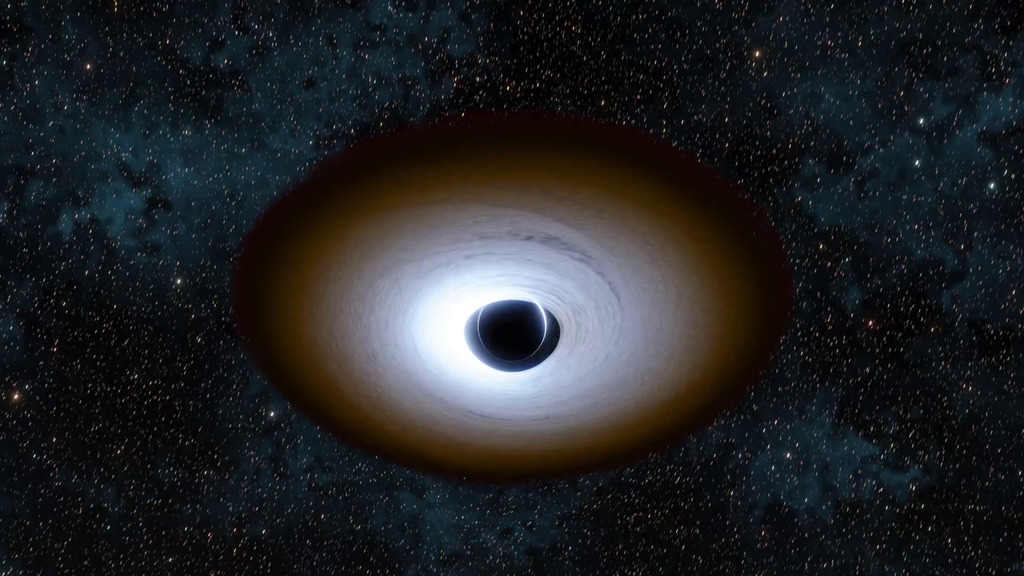Isolated Black Hole Visualization
This visualization shows the strange ways that light is gravitationally warped in the region around a black hole. The distortions seen in this image are due to the physics of general relativity, which informs us how the path of light is deflected in the presence of a gravitational field.
The material forming a black hole has been compressed to densities so high that it is hidden within an “event horizon,” beyond which the gravitational field is so strong that nothing, not even light, can escape. Outside of this event horizon light paths will bend sharply, and even loop around the black hole, under the influence of the intense gravitational fields.
The gravitational warping of the light from background stars is strong, creating the effect of a powerful lens. Light from the region directly behind the black hole forms an “Einstein Ring” that encircles the event horizon. Inside this ring we find an inverted view of the entire sky, which is increasingly distorted. The inner black disk is known as the black hole’s “shadow” which appears slightly larger than the actual location of the event horizon due to the distortion of the light paths.
These illustrations depict what is known as a “Schwarzschild” black hole, made from material that had no overall rotation. A black hole created from rapidly spinning material retains a sense of this rotation and displays additional asymmetries not pictured here; this is known as a “Kerr” black hole.
The appearance a black hole like this is “scale invariant,” meaning that the way light warps around it will appear the same, regardless of the mass of the object. The only thing that changes is the overall size of the distortions and shadow. Thus a black hole ten times as massive as the one shown here, viewed from ten times further away, would look exactly the same.
These animations show qualitatively correct depictions of light distortion around a black hole that use a simplified optical model for the effect, rather than full general relativistic ray-tracing code.
In this video the camera orbits around a bare black hole, getting closer to it over time. The black hole is only seen because of the way light warps around it. Note how an inverted view of the sky appears inside the “Einstein Ring” surrounding the black hole’s shadow. Features that are about to move into the left side of the frame can first be seen slowly moving away from the right side of the black hole’s shadow.
In this video the camera approaches a bare black hole, which almost fills the frame by the end. This gives a sense of what falling into a black hole would look like as one’s view of the sky was increasingly dominated by the black hole’s shadow, and the inverted view of the sky around it.
This video illustrates how a star can be shredded into a streamer of hot gas as it passes close to a supermassive black hole. Such encounters are known as “Tidal Disruption Events” or TDEs. It is the tremendous shear forces causes by the rapidly-increasing pull of gravity that effectively stretches the stars material out into a long stream as the stellar material in the side closer to the black hole is accelerated faster than the side that is farther away.
Note that in most TDEs that the streamer of hot gas does not immediately form an accretion disk, but must lose orbital energy over multiple passes before it can fall closer to the black hole. This movie depicts only the first orbital pass of such a system.
Credits
Please give credit for this item to:
NASA/JPL-Caltech/R. Hurt (IPAC)
-
Visualizer
- Robert Hurt (Caltech-IPAC)
-
Producers
- Keith Miller (Caltech-IPAC)
- Chelsea Gohd (NASA/JPL)
-
Science writer
- Robert Hurt (Caltech-IPAC)
-
Technical support
- Ella Kaplan (Global Science and Technology, Inc.)
- Mark SubbaRao (NASA/GSFC)
Release date
This page was originally published on Wednesday, July 17, 2024.
This page was last updated on Tuesday, July 2, 2024 at 12:14 PM EDT.

](/vis/a010000/a014600/a014621/JPL_Explainers_BH_FINAL.00096_print.jpg)